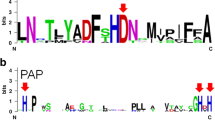Abstract
Extracellular phytase produced by Aspergillus sp. 5990 showed a 5-fold higher activity in liquid culture when compared with cultures of Aspergillus ficuum NRRL 3135. The optimum fermentation conditions were determined to be 35 °C, neutral pH, and 4 days incubation. The phytase had a higher optimum temperature for its activity than the commercial enzyme, Natuphos, from Aspergillus ficuum NRRL 3135.
Similar content being viewed by others
References
Chelius MK, Wodzinski RJ (1994) Strain improvement of Aspergillus niger for phytase production. Appl. Microbiol. Biotechnol. 41: 79–83.
Cheryan M (1980) Phytic acid interactions in food systems. CRC Crit. Rev. Food Sci. Nutr. 13: 297–335.
Dvorakova J, Volfova O, Kopecky J (1997) Characterization of phytase produced from Aspergillus niger. Folia Microbiol. 42: 349–352.
Gargova S, Roshkova Z, Vancheva G (1997) Screening of fungi for phytase production. Biotechnol. Tech. 11: 221–224.
Greiner R, Haller E, Konietzny U, Jany K-D (1997) Purification and characterization of a phytase from Klebsiella terrigena. Arch. Biochem. Biophys. 341: 201–206.
Howson SJ, Davis RP (1983) Production of phytate-hydrolyzing enzyme by some fungi. Enzyme Microbiol. Technol. 5: 377–382.
Kim YO, Kim HK, Bae KS, Yu JH, Oh TK (1998) Purification and properties of a thermostable phytase from Bacillus sp. DS11. Enzyme Microbiol. Technol. 22: 2–7.
Lambrechts C, Boze H, Segueilba L, Moulin G, Galzy P (1992) Utilization of phytate by some yeasts. Biotechnol. Lett. 14: 61–66.
Pasamontes L, Haiker M, Wyss M, Tessier M, van Loon APGM (1997) Gene cloning, purification, and characterization of a heat stable phytase from the fungus Aspergillus fumigatus. Appl. Environ. Microbiol. 63: 1696–1700.
Peddington CS, Houston CS, Paloheimo M, Cantrell M, Miettinen-Oinonen A, Nevalainen H, Rambosek (1993) The cloning and sequencing of the genes encoding phytase (phy) and pH 2.5-optimum acid phosphatase (aph) from Aspergillus niger var. awamori. Gene 133: 55–62.
Shieh TR, Ware JH (1968) Survey of microorganisms for the production of extracellular phytase. Appl. Microbiol. 16: 1348–1351.
Shimizu M (1993) Purification and characterization of phytase from Bacillus subtilis (natto) N-77. Biosci. Biotech. Biochem. 56: 1266–1269.
Ullah AHJ, Gibson DM (1987) Extracellular phytase (E.C. 3.1.3.8.) from Aspergillus ficuum NRRL 3135: purification and characterization. Prep. Biochem. 17: 63–91.
Utt EA (1987) The strain improvement of Aspergillus ficuum NRRL 3135. MSc Thesis. Florida, USA: University of Central Florida.
Wyss M, Brugger R, Kronenberger A, Remy R, Fimbel R, Oesterhelt G, Lehmann M, van Loon APGM (1999) Biochemical characterization of fungal phytases (myo-inositol hexakisphosphate phosphohydrolases): catalytic properties. Appl. Environ. Microbiol. 65: 367–373.
Author information
Authors and Affiliations
Rights and permissions
About this article
Cite this article
Kim, DS., Godber, J.S. & Kim, HR. Culture conditions for a new phytase-producing fungus. Biotechnology Letters 21, 1077–1081 (1999). https://doi.org/10.1023/A:1005696829168
Issue Date:
DOI: https://doi.org/10.1023/A:1005696829168




